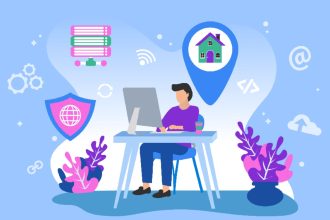Introduction
The digital revolution has profoundly impacted various sectors, and education is no exception. The rise of online learning, powered by innovative technology tools, has reshaped the educational landscape, creating a paradigm shift in how knowledge is imparted and received. This transformation has been further accelerated by the global pandemic, which necessitated a swift transition to remote learning, thereby underscoring the critical role of technology in education.
A quote from a McKinsey article encapsulates the impact of technology on education: “The promise of technology in the classroom is great: enabling personalized, mastery-based learning; saving teacher time; and equipping students with the digital skills they will need for 21st-century careers. Indeed, controlled pilot studies have shown meaningful improvements in student outcomes through personalized blended learning. During this time of school shutdowns and remote learning, education technology has become a lifeline for the continuation of learning.”
This quote underscores the transformative potential of technology in education, highlighting its role in facilitating personalized learning, enhancing teacher efficiency, and preparing students for future careers in an increasingly digital world.
E-Learning Platforms: The New Classroom
In the digital age, e-learning platforms have emerged as the new classrooms, offering a plethora of courses and learning opportunities to students worldwide. Popular platforms such as Coursera, Khan Academy, Udemy, and Codecademy have revolutionized the way we learn, making education more accessible and flexible than ever before.
Coursera, for instance, provides a wide range of virtual courses, certifications, and degree content, making it an excellent option for those looking to enhance their skills or change careers. On the other hand, Khan Academy stands out as a specialized platform for online learning, catering primarily to students from kindergarten through eighth grade. However, its educational reach extends beyond this, offering a range of courses designed for high school and college students as well. It offers a wealth of courses in topics like math, reading, computers, and social and emotional development, all for free.
These platforms are not just repositories of knowledge; they are dynamic learning environments that offer features such as video-based lessons, one-on-one learning, and group learning. They provide students with the flexibility to learn at their own pace, from any location, and at any time. This flexibility, coupled with the ability to access top-notch educational content, makes these platforms a powerful tool in fostering a flexible learning environment.
Moreover, these platforms also offer benefits such as not having to relocate or commute, deciding your learning space, keeping working while enrolled, and learning from top universities or industry-leading companies. They also tend to be more cost-effective compared to in-person learning.
In essence, e-learning platforms are reshaping education by breaking down the barriers of traditional learning and making education a more personalized and user-centric experience.
Interactive Whiteboards and Virtual Classrooms
Interactive whiteboards are digital tools that transform the traditional teaching blackboard into a dynamic learning environment. They allow teachers to present information in a more engaging and interactive way, using multimedia resources such as videos, images, and interactive games. These boards can be connected to the internet, enabling real-time information updates and the use of online resources. They also allow for the recording and saving of the work done on the board, which can be reviewed later or shared with students for further study. Interactive whiteboards encourage student participation, collaboration, and engagement, making learning more effective and enjoyable.
Virtual classrooms, on the other hand, are online learning spaces that simulate the experience of a physical classroom. They have become a crucial component of distance learning, providing a platform where teachers and students can interact in real-time, despite being in different geographical locations. Virtual classrooms offer features such as video conferencing, digital whiteboards, instant messaging, and participation controls, which facilitate communication, collaboration, and learning. They also provide flexibility, allowing students to learn at their own pace and according to their schedules.
Virtual classrooms have been used in various ways in distance learning. Some courses are fully online, with all interactions and learning activities taking place in the virtual classroom. Others use a blended approach, combining online and face-to-face learning. For instance, the “enriched virtual” model involves mostly online teaching with occasional offline components for one-on-one meetings or personal assistance. The “rotation” model combines virtual learning with live, in-person lessons in a fixed schedule, often used in a flipped classroom setting where primary learning happens online, and in-person meetings are for reinforcement and review.
In the wake of the COVID-19 pandemic, the use of virtual classrooms has increased significantly. They have proven to be a viable alternative to traditional classrooms, offering a combination of remote delivery and face-to-face interaction, referred to as the HyFlex model. This model allows students to attend classes either online or in person, depending on their preference or circumstances.
Interactive whiteboards and virtual classrooms are revolutionizing the way we teach and learn. They offer a more engaging, flexible, and inclusive learning experience, making education more accessible to everyone, regardless of their location or circumstances.
Educational Mobile Apps: Learning at Your Fingertips
In the era of smartphones, learning has become more accessible and convenient than ever before. Educational mobile apps like Duolingo, Photomath, and Khan Academy have become indispensable tools that supplement classroom learning, offering a wealth of resources at your fingertips.
Duolingo, for instance, has revolutionized language learning. With its gamified approach, learning a new language becomes an engaging and enjoyable process. The app offers over 30 languages and provides mini-games to help users practice their vocabulary and grammar skills. It also sends daily reminders to encourage consistent learning, making it an effective tool for language acquisition.
Photomath, on the other hand, is a boon for students grappling with math problems. This app allows users to take pictures of math problems and then provides step-by-step solutions. It not only helps students solve problems but also enhances their understanding of mathematical concepts by explaining the solution process.
These educational apps offer numerous benefits. They provide personalized learning experiences, allowing users to learn at their own pace. They also offer the convenience of learning anytime, anywhere, making education more flexible and accessible. Moreover, these apps often employ interactive and engaging teaching methods, which can enhance understanding and retention of knowledge.
In conclusion, educational mobile apps are playing a crucial role in modern education. They supplement classroom learning, provide personalized and convenient learning experiences, and make education more engaging and enjoyable. As technology continues to evolve, we can expect these apps to become even more integral to the learning process.
Screen Recording Tools: A Key Aid for Educators and Students
In the digital education landscape, screen recording tools have emerged as a pivotal component, revolutionizing the way educators teach and students learn. These tools have significantly enhanced the teaching and learning process, enabling a more interactive and engaging educational experience.
For educators, screen recording tools offer the ability to create dynamic video lessons, demonstrations, and tutorials. The ability to record and share their screens allows them to provide visual and auditory learning materials that students can access and review at their own pace. This is particularly beneficial for complex topics that require step-by-step explanations or demonstrations.
Students, on the other hand, can leverage these tools for note-taking, replaying lectures, and even recording their own screens to demonstrate their understanding of a topic or to ask specific questions about a task. This can enhance their learning experience, allowing them to review and understand complex topics at their own pace.
In the realm of these tools, the screen recorder tool Mac stands out as a particularly user-friendly and efficient option. It offers a variety of features that cater to the diverse needs of educators and students alike. These include smooth cursor movement, auto-zoom and auto-follow clicks, and customizable backgrounds. Furthermore, it provides a variety of export options, catering to different user needs and preferences.
Screen recording tools are playing a significant role in digital education. They are enhancing the teaching and learning process by facilitating the creation of dynamic learning materials and enabling personalized learning experiences. As technology continues to evolve, we can expect these tools, including the screen recorder tool for Mac, to become even more integral to the education sector.
Artificial Intelligence (AI) in Education: The Future?
Artificial Intelligence (AI) holds immense potential in transforming the future of education. It can address some of the biggest challenges in education today, innovate teaching and learning practices, and accelerate progress towards sustainable development goals. AI can play a significant role in addressing current inequalities regarding access to knowledge, research, and the diversity of cultural expressions, ensuring that it does not widen the technological divides within and between countries.
AI is already being used in education in various ways. For instance, AI tutors are being used to provide personalized learning experiences to students. These AI tutors can adapt to a student’s learning style and pace, providing customized learning materials and feedback. This can enhance the learning experience, making it more effective and enjoyable.
AI is also being used for grading assignments and exams. This not only saves time for teachers but also ensures unbiased and consistent grading. Moreover, AI can provide instant feedback to students, helping them understand their mistakes and improve their performance.
The U.S. Department of Education’s Office of Educational Technology recently released a policy report titled “Artificial Intelligence and the Future of Teaching and Learning: Insights and Recommendations”. This comprehensive document underscores the importance of disseminating knowledge, involving educators, and fine-tuning technological strategies and policies for the application of Artificial Intelligence (AI) in the educational sector. The report characterizes AI as an evolving suite of technologies designed to identify patterns in data and automate tasks. It serves as a guide for educators, helping them comprehend the potential of these burgeoning technologies to propel educational objectives, while also assessing and mitigating associated risks.
AI has the potential to revolutionize education, making it more personalized, effective, and accessible. As technology continues to evolve, we can expect AI to play an even more significant role in the future of education.
Conclusion
The digital revolution in education has brought forth a plethora of tech tools that are reshaping the way we learn and teach. From e-learning platforms to interactive whiteboards, mobile apps, and screen recording tools, these innovations are fostering a more flexible, accessible, and personalized learning environment. Screen recording tools, in particular, have emerged as a key aid for both educators and students, enabling the creation of video lessons, demonstrations, and facilitating note-taking and replaying of lectures.
As we look to the future, the words of Sir Ken Robinson, a renowned creativity expert, resonate deeply. He said, “Every education system in the world is being reformed at the moment and it’s not enough. Reform is no use anymore, because that’s simply improving a broken model. What we need…is not evolution, but a revolution in education. This has to be transformed into something else. So when we look at reforming education and transforming it, it isn’t like cloning a system. There are many great models. It’s about customizing to your circumstances and personalizing education to the people you’re actually teaching. And doing that, I think, is the answer to the future because it’s not about scaling a new solution; it’s about creating a movement in education in which people develop their own solutions, but with external support based on a personalized curriculum.”
Indeed, the revolution is here, and it is digital. As we continue to embrace and harness these tech tools, we are not just improving education; we are transforming it.















